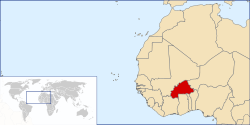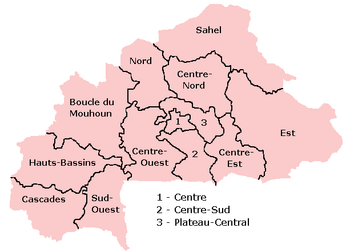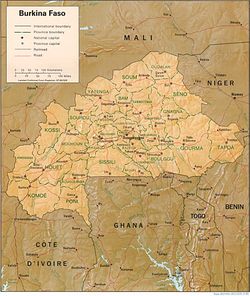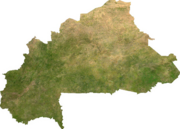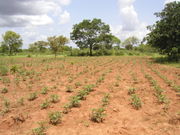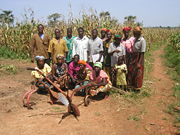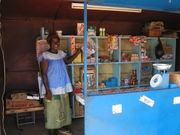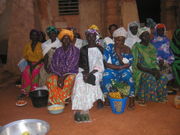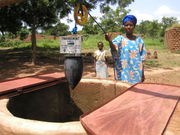Burkina Faso
2008/9 Schools Wikipedia Selection. Related subjects: Africa; African Countries
| Burkina Faso | ||||||
|---|---|---|---|---|---|---|
|
||||||
| Motto: "Unité, Progrès, Justice" (French) "Unity, Progress, Justice" |
||||||
| Anthem: Une Seule Nuit (French) One Single Night |
||||||
|
|
||||||
| Capital (and largest city) |
Ouagadougou |
|||||
| Official languages | French | |||||
| Demonym | Burkinabé | |||||
| Government | Semi-presidential republic | |||||
| - | President | Blaise Compaoré | ||||
| - | Prime Minister | Tertius Zongo | ||||
| Independence | from France | |||||
| - | Date | August 5, 1960 | ||||
| Area | ||||||
| - | Total | 274,000 km² ( 74th) 105,792 sq mi |
||||
| - | Water (%) | 0.1% | ||||
| Population | ||||||
| - | 2005 estimate | 13,228,000 ( 66th) | ||||
| - | 1996 census | 10,312,669 | ||||
| - | Density | 48/km² ( 145th) 124/sq mi |
||||
| GDP ( PPP) | 2005 estimate | |||||
| - | Total | $16.845 billion1 ( 117th) | ||||
| - | Per capita | $1,284 ( 163rd) | ||||
| Gini (2003) | 39.5 (medium) | |||||
| HDI (2007) | ▲ 0.370 (low) ( 176th) | |||||
| Currency | West African CFA franc ( XOF) |
|||||
| Time zone | GMT | |||||
| Internet TLD | .bf | |||||
| Calling code | +226 | |||||
| 1 | The data here is an estimation for the year 2005 produced by the International Monetary Fund in April 2005. | |||||
Burkina Faso (pronounced /bɚˌkiːnəˈfɑːsoʊ/ burr-KEE-na FAH-soh), also known by its short-form name Burkina, is a landlocked nation in West Africa. It is surrounded by six countries: Mali to the north, Niger to the east, Benin to the south east, Togo and Ghana to the south, and Côte d'Ivoire to the south west. Formerly called the Republic of Upper Volta, it was renamed on August 4, 1984, by President Thomas Sankara to mean "the land of upright people" in Moré and Dioula, the major native languages of the country. Literally, "Burkina" may be translated, "men of integrity," from the Moré language, and "Faso" means "father's house" in Dioula.
Independence from France came in 1960. Governmental instability during the 1970s and 1980s was followed by multiparty elections in the early 1990s. Several hundred thousand farm workers migrate south every year to Côte d'Ivoire and Ghana in search of paid labour. The inhabitants of Burkina Faso are known as Burkinabé (pronounced /bɚˈkiːnəbeɪ/ burr-KEE-na-bay).
History
Early history
Typical of West Africa, Burkina Faso was populated early, notably by hunter-gatherers in the northwestern part of the country (12,000 to 5000 BC), and whose tools (scrapers, chisels and arrowheads) were discovered in 1973. Settlements appeared between 3600 and 2600 BC with farmers, the traces of whose structures leave the impression of relatively permanent buildings. The use of iron, ceramics and polished stone developed between 1500 and 1000 BC, as well as a preoccupation with spiritual matters, as shown by the burial remains which have been discovered.
Relics of the Dogon are found in the centre-north, north and north-west region. They left the area between the fifteenth and sixteenth centuries BC to settle in the cliffs of Bandiagara. Elsewhere, the remains of high walls are localised in the southwest of Burkina Faso (as well as in the Côte d'Ivoire), but the people who built them have not yet been definitely identified.
Burkina Faso was a very important economic region for the Songhai Empire during the fifteenth and sixteenth centuries.
From colony to independence
After a decade of intense rivalry and competition between the British and the French, waged through treaty making expeditions under military or civilian explorers, in 1896, the Mossi kingdom of Ouagadougou was defeated by French colonial forces and became a French protectorate. The western region, where a standoff against the forces of the powerful ruler Samori Ture complicated the situation, and the eastern region came under French occupation in 1897 following different campaigns. By 1898, the majority of the territory corresponding to Burkina Faso today was nominally conquered, although control of many parts remained precarious. The French and British convention of June 14, 1898 ended the scramble between the two colonial powers and basically traced the borders between them. On the French side a war of conquest against local communities and political powers continued for about five years. In the 1904 large-scale reorganization of the French West African colonial empire, the now largely pacified territories of the Volta basin were integrated into the Upper Senegal and Niger (Haut-Sénégal et Niger) colony of French West Africa (AOF). The colony had its capital in Bamako.
Draftees from the territory participated in the European fronts of First World War in the battalions of the Senegalese Infantry (Tirailleurs sénégalais). Between 1915 and 1916 the districts in the western part of what is now Burkina Faso and the bordering eastern fringe of Mali became the stage of one of the most important armed oppositions to colonial government (known as the Volta-Bani War). The French government finally suppressed the movement, but only after suffering defeats and being forced to gather the largest expeditionary force of its colonial history up to then. Armed opposition also wrecked the Sahelian north, as the Tuareg and allied groups of the Dori region ended their truce with the government. Once the First World War was over, on March 1, 1919, fear of recurrence of armed uprising and economic considerations led the colonial government to separate the present territory of Burkina Faso from Haut Sénégal et Niger so as to intensify its administration. The new colony was named Upper Volta (Haute Volta) and François Charles Alexis Édouard Hesling became its first governor. Hesling initiated an ambitious road making program and promoted cotton growing for export. The cotton policy, based on coercion, failed and revenue stagnated. The colony was dismantled on September 5, 1932, and its territory divided between Côte d’Ivoire, French Sudan and Niger, the largest share with most of the population and the cities of Ouagadougou and Bobo-Dioulasso passing to Côte d'Ivoire.
The decision was reversed during the intense anti-colonial agitation that followed the end of the Second World War and on September 4, 1947 Upper Volta was recreated in its 1932 boundaries under the French Union. On December 11, 1958, it achieved self-government, and became the Republic of Upper Volta and member of the Franco-African Community (La Communauté Franco-Africaine). Full independence was attained in 1960. The country's first military coup occurred in 1966; which returned civilian rule in 1978. There was another coup, led by Saye Zerbo in 1980, which in turn was overthrown in 1982. A counter-coup was launched in 1983, which brought the charismatic Captain Thomas Sankara to leadership. In 1984 the revolutionary government changed the name of the country to Burkina Faso, its flag, and its national anthem. The current president is Blaise Compaoré, who came to power in 1987 after a coup d'état that killed Thomas Sankara.
Politics
The constitution of June 2, 1991 established a semi-presidential government with a parliament (Assemblée) which can be dissolved by the President of the Republic, who is elected for a term of seven years. In 2000, however, there was a constitutional amendment reducing the presidential term from seven to five years, which was enforced during the 2005 elections. Another change according to the amendment would have prevented sitting President, Blaise Compaoré from being re-elected. However, notwithstanding a challenge by other presidential candidates, in October 2005 the constitutional council ruled that because Compaoré was already a sitting president in 2000, the amendment would not apply to him until the end of his second term in office. This cleared the way for his candidacy in the 2005 election. On November 13, Compaoré was reelected in a landslide due to a divided political opposition.
The parliament consists of two chambers: the lower house (l'Assemblée Nationale) and the upper house (la Chambre des Représentants). There is also a constitutional chamber, composed of ten members, and an economic and social council whose roles are purely consultative.
Regions, provinces, and departements
Burkina Faso is divided into thirteen regions, forty-five provinces, and 301 departements. The regions are:
- Boucle du Mouhoun
- Cascades
- Centre
- Centre-Est
- Centre-Nord
- Centre-Ouest
- Centre-Sud
- Est
- Hauts-Bassins
- Nord
- Plateau-Central
- Sahel
- Sud-Ouest
Geography
Burkina Faso is made up of two major types of countryside:
- The larger part of the country is covered by a peneplain which forms a gently undulating landscape with, in some areas, a few isolated hills, the last vestiges of a Precambrian massif.
- The south-west of the country forms a sandstone massif, where the highest peak is found: Ténakourou (749 m, 2,450 ft). The massif is bordered by sheer cliffs up to 150 metres (490 ft) high.
The average altitude is 400 metres (1,300 ft) and the difference between the highest and lowest terrain is no greater than 600 metres (2,000 ft). Burkina Faso is therefore a relatively flat country, with a very few localised exceptions.
Hydrography
The country owed its former name of Upper Volta to three rivers which cross it: the Mouhoun (formerly called the Black Volta), the Nakambé (the White Volta) and the Nazinon (the Red Volta). The Mouhoun, along with the Comoé which flows to the south west, is the country's only river which flows year-round
The basin of the Niger River also drains 27% of the country's surface. Its tributaries (the Béli, the Gorouol, the Goudébo and the Dargol) are seasonal streams, and only flow for 4 to 6 months a year but can cause large floods.
The country also contains numerous lakes. The principal lakes are Tingrela, Bam and Dem, and the large ponds of Oursi, Béli, Yomboli and Markoye.
Water shortages are often a problem, especially in the north of the country.
Climate
Burkina Faso has a primarily tropical climate with two very distinct seasons: the rainy season with between 24-35 inches (600 and 900 mm) of rainfall, and the dry season during which the harmattan, a hot dry wind from the Sahara, blows. The rainy season lasts approximately 4 months, May/June to September, and is shorter in the north of the country.
Three large climatic zones can be defined:
Sahel Zone
The Sahel in the north typically receives less than 24 inches (600 mm) rainfall a year and high temperatures 5–47 ° C (40–115 ° F). A relatively dry tropical savanna, the Sahel extends beyond the borders of Burkina Faso, from the Horn of Africa to the Atlantic Ocean, and borders the Sahara to its north, and the fertile region of the Sudan to the South. Extreme temperatures recorded are 5.5C and 47.0C.
Sudan-Sahel zone
Situated between 11°3' and 13°5' north latitude, the Sudan-Sahel region is a transitional zone with regards to rainfall and temperature.
Sudan-Guinea zone
Further to the south, the Sudan-Guinea zone receives more than 35 inches (900 mm) of rain a year and cooler average temperatures.
Economy
Burkina Faso has one of the lowest GDP per capita incomes in the world: $1,200. This ranks it as the 127th poorest nation. Agriculture represents 32% of its gross domestic product and occupies 80% of the working population. It consists mostly of livestock but also, especially in the south and southwest, of growing sorghum, pearl millet, maize (corn), peanuts, rice and cotton.
Unemployment causes a high rate of emigration: for example, three million citizens of Burkina Faso live in Côte d'Ivoire. According to the Central Bank of Western African States ( Banque Centrale des États de l'Afrique de l'Ouest), these migrants send tens of billions of Euros back to Burkina Faso each year. Since the 1967 expulsions from Ghana, this situation has provoked tensions in the recipient countries. The most recent crisis occurred owing to the events of 2003 in Côte d'Ivoire, which led to the return of 300,000 migrants.
A large part of the economic activity of the country is funded by international aid.
The currency of Burkina Faso is the CFA franc.
There is mineral exploitation of copper, iron, manganese and, above all, gold.
Burkina Faso also hosts the International Art and Craft Fair, Ouagadougou, better known by its French name as SIAO, Le Salon International de l' Artisanat de Ouagadougou, one of the most important African handicraft fairs.
Demographics
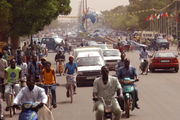
Burkina Faso has an estimated life expectancy at birth of slightly under 50 years of age. The median age of its inhabitants is under 17.
Population growth rate: 3.00% (2006)
The population is concentrated in the south and centre of the country, sometimes exceeding 48 per square kilometer (125/ sq. mi.). This high population density, causes annual migrations of hundreds of thousands, for seasonal employment.
Approximately 50% of the population is Muslim; Christians account for about 30%, and followers of traditional African religions (typically animism of various forms) make up about 20%. Many Christians incorporate elements of animism into their religious practices.
Education
Education in Burkina Faso is divided into primary, secondary, and higher education. However, schooling is not free. Secondary school costs approximately $115 (50,000CFA) a year, which is far above the means of most Burkinabe families. Boys receive preference in schooling; as such, girls' education and literacy rates are far lower. An increase in girls' schooling has been observed due to the government's policy of making school cheaper for girls and granting them more scholarships. In order to proceed from elementary to middle school, middle to high school, or high school to college, national exams must be passed. Institutions of higher education include the University of Ouagadougou, and The Polytechnical University in Bobo-Dioulasso, the University of Koudougou, which is also a teacher training institution. A number of private colleges for specific trainings have recently appeared in the capital city Ouagadougou but are affordable to a very small portion of the population.
There is also an International School of Ouagadougou (ISO), which is an American-based private school located in the capital city, Ouagadougou.
The United Nations Development Program Report used to place Burkina Faso as the most illiterate country in the world, with only 12.8% in 1990. However, with the consistent effort of the government in making schooling more accessible and affordable, the literacy rate has doubled and is now at 25.3% of the population.


